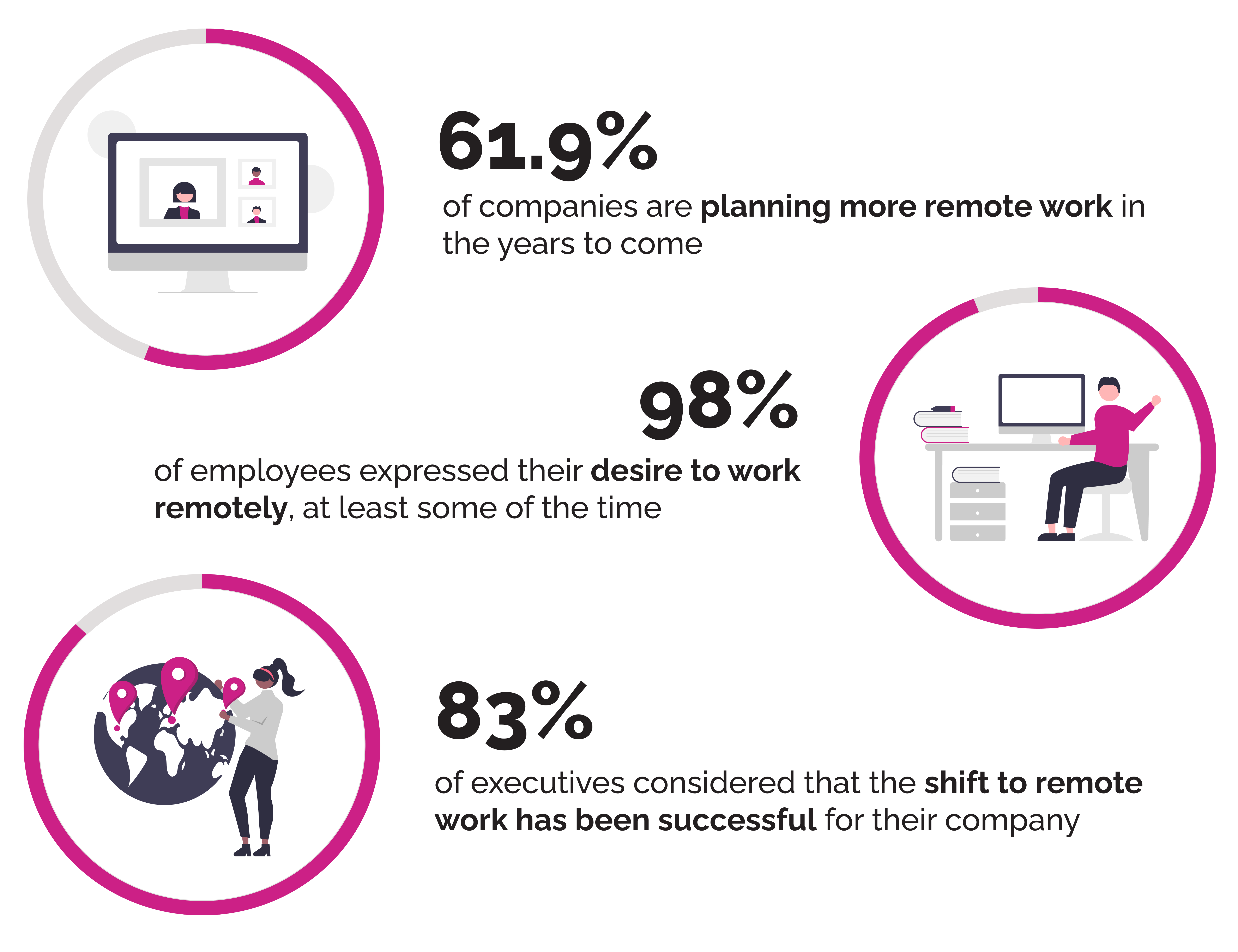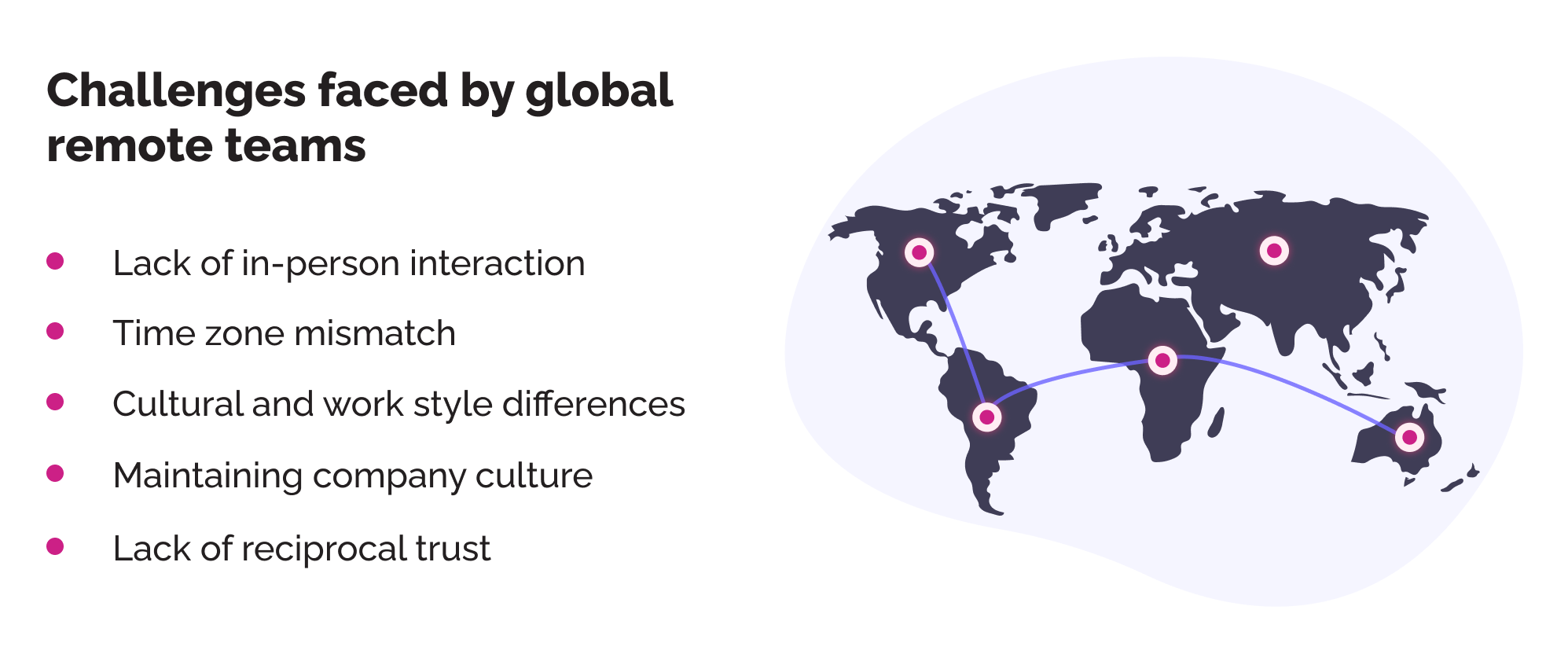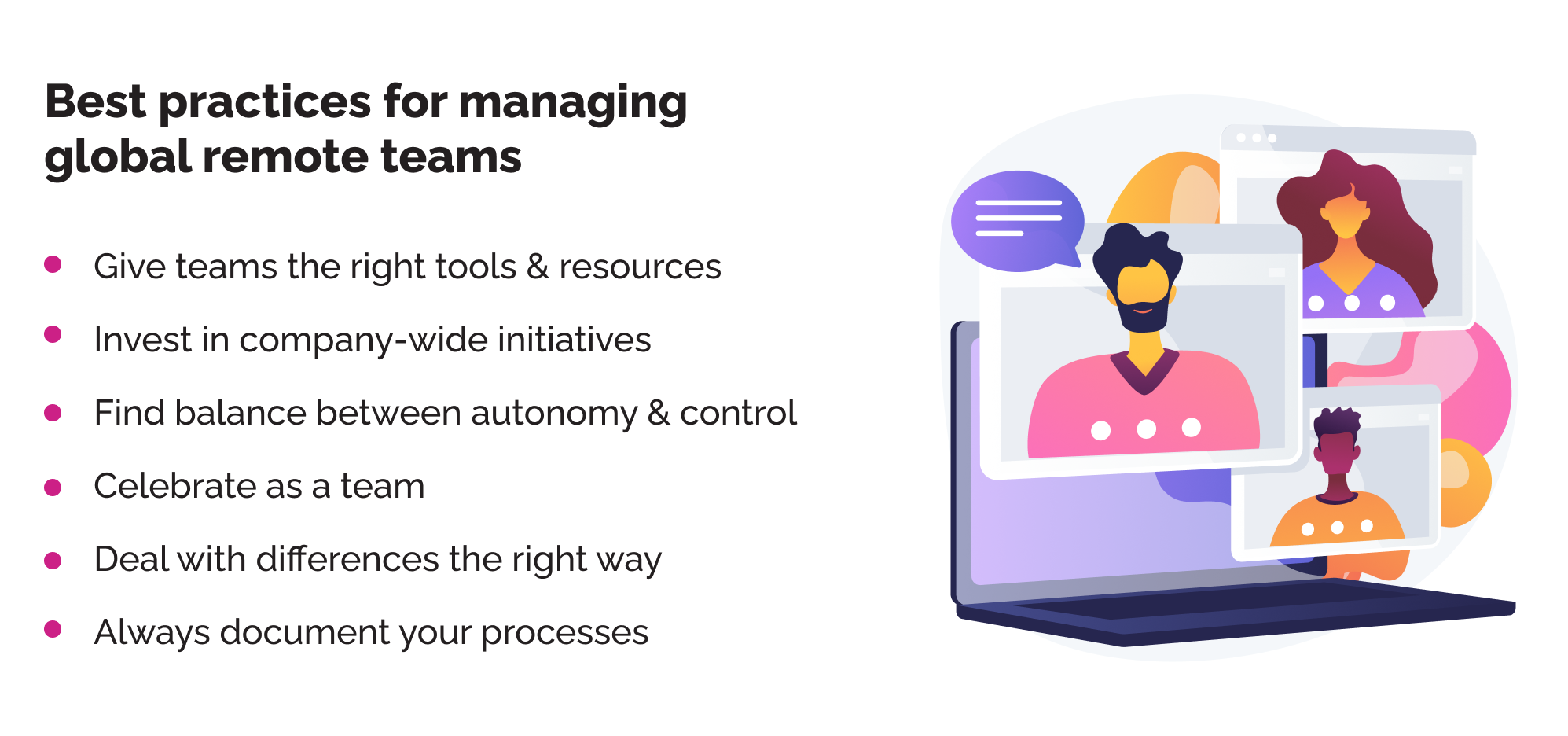More and more companies are relying on teams spread across countries and continents to get the best expertise from around the world or tap into local knowledge of promising markets. But with these opportunities, also come unique challenges that sometimes baffle even the most skilled managers.
Creating successful work groups and healthy dynamics is tough enough when everyone shares the same office. What about when employees live in different countries and time zones, have different work styles, or come from different cultural backgrounds?
As a software development company with team members in 17 locations on 4 continents, we’ve definitely felt the heat.
However, we’ve also learned a lot of valuable lessons along the way, including how to approach working remotely in a way that empowers team members no matter where they are.
Although software development is particularly fit for fully remote work enabling many tech companies to adopt a remote model even before the pandemic, those businesses that are just now considering it may struggle with managing teams, especially on a global scale.
For this purpose, we’re going to be sharing in this article some of our best tips on managing remote international teams. But first, let’s look at why managers need to prepare their teams for globalization in the first place.
Remote work is here to stay
News of companies requiring employees to return to the office after the pandemic has generated doubts about the longevity of remote work. However, this is hardly the case, as statistics are, in fact, consistently trending up:
-
61.9% of companies are planning more remote work in the years to come, accelerating an already existing trend.
-
This is in line with employee expectations, since a staggering 98% of workers expressed the desire to work remotely, at least some of the time. Remote work has become one of the most sought-after benefits, especially by highly skilled workers like developers.
-
A similar research conducted by PwC revealed that 83% of surveyed executives considered that the shift to remote work has been successful for their company. This signals an increasingly positive attitude towards remote work compared to the beginning of the pandemic.
Today, 16% of companies in the world operate without a physical office. Whether fully virtual or hybrid, data suggests that remote work is here to stay, especially given the hiring challenges companies continue to face and the tight labor market.

Why the future of remote work is global
Just like the first wave normalized remote work, during the second wave, we’re likely to see more and more companies turning towards remote international teams to stay ahead of the game. There are a few reasons for this.
Companies use global teams to address talent shortages
Real talent is hard to find and hire regardless, but it’s particularly challenging in competitive industries like IT. We’ve talked about why this is the case in our article - “How to Hire Software Developers Like a Pro: ETEAM's Approach”.
The demand for skilled engineers not only surpasses the offer but engineers also have a more dynamic job search experience, with many companies competing for their attention. By removing geographic limitations, companies in industries facing a talent gap can open up their hiring efforts to an international candidate pool.
Dispersed teams improve business agility and crisis response
Global teams improve business agility by providing round-the-clock service and faster response times. Also, because they are spread across different locations when one location is affected by a crisis, work can continue in unaffected regions or employees can be quickly relocated to safety.
This is particularly relevant in today’s turbulent times, with many Ukrainian companies, including ETEAM, turning to a global remote work model to protect their teams from the effects of war and guarantee business continuity and service quality.
Employees enjoy higher levels of job satisfaction and productivity
A study conducted by Owl Labs in 2023 revealed that 79% of workers report feeling more satisfied with their jobs when they can work remotely. By removing the stress associated with commuting and a fixed work schedule, remote work positively impacts employee well-being and has also been shown to increase productivity.
In fact, there is a proven relationship between job satisfaction and productivity. Research showed that, on average, workers who are satisfied with their jobs are 31% more productive. Satisfied employees are also more likely to stay with the company, with established remote teams having some of the best retention rates globally. Gitlab, one of the world's largest all-remote organizations, has an astounding retention rate of 84%.
Global teams boost inclusiveness and innovation opportunities
International teams bring together talent from different backgrounds and with various points of view, opinions, and experiences. Companies that manage this diversity well, can create not only a more inclusive environment but also a place where ideas can roam freely. This type of creative problem-solving and out-of-the-box thinking is essential for organizations looking to win the digital transformation race.
Companies that work with dispersed teams also have a double advantage. On the one hand, they support local economies, building quality relationships, and on the other hand, they can tap into the local knowledge of promising markets to uncover new business opportunities.
Challenges faced by global remote teams
As we've seen so far, more and more companies are relying on globally dispersed teams to attract the best talent, successfully overcome disturbances, or stay ahead of the competition.
However, leading an international digital team means facing a unique set of challenges that are, from our experience, quite different from managing any other sort of team.
Lack of in-person interaction
Unlike teams that work near the office and can meet periodically or at least travel to company events, most of the team members working across the world will likely never see each other in person.
This makes creating a sense of belonging and cohesion a lot more difficult, as most HR managers can probably tell you. Lack of in-person bonding is the biggest remote work killer and one of the most frequent causes of conflict, misunderstanding, and feelings of isolation in the workplace.
Time zone mismatch
One of the greatest freedoms brought by remote work is the ability to hire talent from around the world. The downside is that much of this talent can be working in different time zones, which can put your team out of sync.
While a part of the team might be snoozing, another part might be trying to get things done on the other side of the globe. Delays in communication and decision-making caused by significant time differences can not only disrupt workflows but can also make parts of your team that are not in the “official” time zone feel ignored.
Cultural and work style differences
Distributed teams often come from a variety of cultural backgrounds which translates into different attitudes toward work, punctuality, communication, or overall commitment levels.
As a result, team members might have a hard time understanding each other’s perspectives or working together effectively. Managers are faced with the challenge of finding common ground, while also capitalizing on the unique strengths of culturally diverse teams.
Difficulties in maintaining company culture
If you are a company that shifted from working in the office to virtual teams, it’s important to recognize that your company culture might not automatically transfer. Efforts need to be made to bring new life into your company values and embed them into daily operations in a way that is remote-friendly.
Building and maintaining a unified company culture across geographically distributed teams is one of the biggest challenges for companies with a global workforce.
Lack of reciprocal trust
In the absence of proper communication and feedback, team members working remotely may feel easily disposable, especially if they work on a contract or collaboration basis. This might lead them to not trust the company or feel like they can be easily replaced with another remote worker if anything happens.
On the other hand, companies might also have a hard time trusting their remote teams to do their jobs properly, leading to a lot of micromanagement and no space for personal growth or learning from mistakes.

How to build a management strategy that works for global remote teams
While remote work is essential for the long-term success of most organizations, it’s not always easy to implement a strategy that fits global teams and addresses their challenges.
Here are four points you should consider if you are managing a dispersed team, including a few examples from our own experience.
Integrate risk management into your recruitment strategy
At ETEAM we are firm believers that a strong global remote team starts with hiring the right people. However, there is increasing complexity involved with hiring employees in international locations, not only in terms of navigating local regulations but also when it comes to candidate fraud.
Identity theft is particularly prevalent in tech. The huge demand for software developers combined with a generous compensation package can sometimes attract candidates who fake their credentials and pretend to be someone else. And because hiring has gone remote, this is getting harder to spot.
This is why, to reap the benefits of global remote teams, organizations must first manage risk. HR Managers must be thoroughly committed to vetting candidates through reliable background checks and through assessment platforms that are fraud-proof.
Establish communication guidelines and channels
Communication remains one of the biggest challenges for globally dispersed teams and the number one cause of friction. Setting up a communication strategy for your team shouldn’t be limited to collaboration tools and technologies. It should also include guidelines on how to use these channels and what to do in case communication breaks down.
Consider writing everything down in a remote work handbook you can easily reference or share with new team members as needed. We like to think of our remote work handbook as a framework we can fall back on for things like:
-
What are the main communication channels and how should they be used (e.g. limit messages in chat channels to overlapping hours)?
-
How fast are team members expected to respond depending on the channel?
-
How should team members give and receive feedback?
-
What are some best practices when scheduling virtual meetings (e.g. avoid scheduling conflicts to ensure everyone’s time is respected)?
Set clear expectations and track progress
Clear communication goes hand in hand with clear expectations. Make sure everyone understands not only when and how communication should take place but also what their responsibilities are, how performance is evaluated, and if there are any additional expectations.
For example, if a team member is required to join a recurring meeting outside their regular work hours make sure to discuss this beforehand or check if adjustments can be made.
As an HR Manager, I found it extremely important to make yourself available to answer questions, but also to be prepared to review expectations accordingly. Try to track progress consistently and provide feedback based on this.
You don’t have to go with standard KPIs, it can just be a set of common, hard goals your team should focus on meeting weekly, monthly, or quarterly. This way, regardless of their time zone, team members know what is expected of them and you know at a glance who is doing well and who needs help.
Unite teams around shared, actionable values
As we transitioned to fully remote work at ETEAM, we recognized early on that we needed to rethink our approach to company values. As we spread ourselves across 17 countries and several time zones, some things were becoming easier to get lost in translation.
Therefore, we sat down and discussed how we can make our values meaningful and actionable in a way that every team member can relate to regardless of their location. You can read the full story here!
Actionable company values are a great way to keep remote teams connected. When everyone is driven by the same motivation it’s a lot easier to find common ground, especially in culturally diverse teams. Company values can also act as team guidelines. When making decisions, team members can ask themselves: Are my actions aligned with how we do things or do I need to reconsider my decision?
Best practices for managing a globally dispersed team
Any higher-level strategy you set up needs to be backed up by concrete, practical actions.
Below, we outline a few best practices that will allow you to overcome some of the most common challenges associated with managing global remote teams.

1. Give teams the right tools and resources for remote working
As a company working with a widely distributed team, one of the best pieces of advice we can offer is to put in place a highly organized system of remote-friendly resources and tools. Global remote teams work asynchronously, so you need to make sure everyone can complete their tasks without having to be online at the same time.
From scheduling tools to project management software, communication platforms, and file-sharing, these are all part of our daily toolkit.
In addition to setting up your infrastructure, ensure employees have access to all necessary files. If your company does not have a well-maintained document repository, now it’s time to establish it.
2. Build camaraderie through company-wide initiatives and avoid isolation
With remote work, many of the opportunities team members previously had to socialize disappear. There’s no water cooler for employees to chat around and no office foosball table to play with as a team. Companies need to find new ways to build and preserve camaraderie.
Company-wide initiatives are a great way to get together and avoid feelings of isolation. It doesn’t have to be just formal events like company meetings, it can also be hobby-based chat channels, after-hour virtual socials, or even contests (we recently held a pumpkin carving contest for Halloween).
In addition to fun prizes, contests have the added benefit that everyone can submit their entry regardless of what time zone they work in.
3. Strike a good balance between autonomy and control
Distributed teams are evolving from “work from anywhere” to “work from anywhere and at any time”. On the one hand, this requires a change in leadership style to empower more autonomy, but on the other hand, it demands new ways to hold team members accountable. Striking a good balance between autonomy and control is key here.
We found that setting a standard time when all team members should be available for communication regardless of their location helps. This can be a small overlapping window, but it’s still important.
Regular check-ins also ensure that everyone is on the same page and that managers can track progress and provide team members with additional support as needed.
4. Recognize individual achievements but celebrate as a team
It’s important to remind team members that they share a common purpose. A great way to do this is to celebrate whenever certain goals are achieved not just on an individual level but also on a team level. As the saying goes, teams who celebrate together, stay together. You can employ a Kudos system or a celebration bot to automate these tasks and have everyone join in on special occasions.
We recently built our own celebrations bot called Joey that can be easily integrated into any Slack channel. Once added to the channel, JoeyBot notifies all participants of the achievement or special event, so they can congratulate that particular team member, whether it’s a professional milestone or a birthday.
5. Deal with differences the right way
As a manager, it’s very tempting to immediately shut down differences of opinion whenever they arise. You might feel that by doing so you prevent the argument from escalating into full-blown conflict.
However, if handled correctly, conflict can make teams stronger. Disputes allow team members to explore ways of thinking different from theirs and to work together to reach an agreement.
This approach is particularly relevant when you have team members from various backgrounds and with various habits and work styles. Differences will arise, but when managed properly these differences can lead to new ideas and a more tight-knit team in the end.
Of course, you need to carefully assess if the conflict is hurting the team or if it leads to a constructive outcome.
6. Document, document, and then document some more
We’ve been a remote team for some time now which means documents, paperwork, and processes have gotten quite complex, as these things tend to pile up.
One of the best ways to keep it straightforward is to always document your processes, schedules, and resources. We use Confluence to put everything down and create shareable assets we can use during onboarding.
By documenting all important information you have a single source of truth team members can reference in their everyday work. Whether it’s taking a sick day or looking for brand assets, they will know exactly what to do, who to go to, or where to look in every situation.
Of course, all this information evolves together with your team, so it’s important to keep it updated.
Set your global remote team up for success
Managing a global remote team comes with particular challenges, but being able to witness this diversity in action is rewarding, both for leaders and businesses alike. With companies growing internationally, it will become increasingly common to see team members from all over the world collaborate and innovate together.
As managers continue to rethink their remote work strategies, it is essential to empower employees with the best tools, processes, and practices that enable them to thrive and feel connected regardless of their location.








